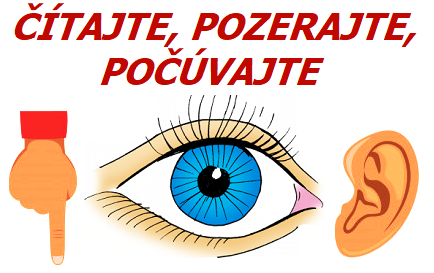08 Vzdelanie - EDUCATION :)
Vytvorené: 27. 02. 2014 Tlačiť
a) School system
The general education is free of charge. If you attend a private school, you have to pay fees. There are state, private and church schools in Slovakia. School attendance is compulsory for children from 6 to 15 years.
Education in Slovakia includes these stages.The pre-school stage provides carefor the youngest children and is not compulsory. Infants and children up to 3 years visit nursery. Children from 3 to 6 years go to nursery schools or kindergartens.
Children start attending primary schools when they are 6 years old and finish when they are 15 years old. Basic education is provided by primary schools. At these schools children learn the three R´s – Reading, writing, aRithmetic, with the subjects such as Slovak, foreign languages – usually English or German, History, Geography, Mathematics, Chemistry, Biology, Physic, Physical Education – PE, Art, Civics. Children who visit primary schools are called pupils.
When pupils finish the primary school, they can choose one of the following secondary schools: secondary grammar school, secondary comprehensive school, trade school or art school.Vocational and technical schools (agricultural, nursing, electro- technical, business and hotel academies) prepare students for their future professions. 3-year secondary vocational schools prepare pupils for practical jobs. Grammar school offers general education and prepares students for higher education. Some of them have to pass an entrance examination to be admitted to a school.To complete secondary education you have to pass the final exam - school-leaving examination.
After studying at secondary schools, students are ready to work or they can continue in their education and study at universities. First of all, students must study hard to pass an entrance examination. In Slovakia, you can study at Comenius University in Bratislava, the University of Pavol Jozef Šafarik in Košice or the Slovak Technical University in Bratislava. The university study takes from 4 to 6 years. When you finish university, you get a diploma and you are awarded a degree, such as Bachelor’s Degree = Bc. or Master’s Degree = Mgr. The most advanced type of degree is a PhD.
The school year in Slovakia starts on second of September and ends on the 30th of June. We have 2 terms – a summer term and a winter term.The summer holidays are the longest and last two months. We also have a few days off school in autumn, during Christmas and a week holiday in spring.Pupils and students are evaluated by marks from 1 to 5 – 1 is the best and 5 is the worst. Each term students get their school report with marks.
b) Teaching
A school day is different at different types of schools. The average number of lessons at a secondary school is around 30 a week, pupils at primary schools have fewer lessons.
A lesson usually lasts 45 minutes. There are breaks between the lessons, which last from 5 to 10 minutes. Teaching usually starts at 8 o´clock and finishes at half past one.
Students and pupils get timetable for the whole week in the beginning of the school year. Subjects taught at a school can be divided into compulsory and optional subjects. The most common subjects in the Slovak schools are Slovak language, English, German, Maths, Geography, Biology and PE. Every school usually has its own canteen where pupils and students can get a proper meal for a low price. There are some special events organized by school, such as school competitions, school trips and parent- teacher associations.
c) Life of a student
The student’s life is very individual. Every student or pupil has to prepare himself for the next day at school which involves at least doing his homework. On the other hand, he should find some free time for his hobbies and friends. Students can choose many after-school activities like sports, drama, hiking or another. During summer holidays a lot of them are searching for a part-time job to earn some extra money. At the secondary school, the young people begin to make real friendship. They look for true love and learn how to become an adult. They have to take responsibility for their actions and behaviour. They make friends for life here and some of them can even find their future life-partner.
d) Foreign languages
One of the biggest advantages of the secondary school is emphasis, which is given on the study of foreign languages. An average graduate must be able to communicate in at least one foreign language. They can choose English, German and French. There are schools which offer Russian, Hungarian, Spanish or even Latin. University and college studies include foreign language too and most of them offer various student exchanges with partner universities abroad. If the students take part in an exchange, they usually live in the families of their exchange partner. A student can be simply sent to study abroad because of his excellent studying results. It’s becoming popular to take a language course in one’s free time because nowadays it is necessary to be able to speak more languages. Another way of gaining language experience is working abroad as an au pair, which means living with a family and looking after the children and sometimes doing the housework.
e) Relationship between a student and a teacher
A student develops a relationship with every teacher he gets in touch with. Mostly is this relationship formal. At the primary schools, teachers are more caring and are interested in the personality of the pupil. At the secondary schools isn´t the relationship as close as at the primary schools. A good teacher should be tolerant and helpful, but strict. On the other hand, a good student should be polite, obedient and hard working. A good teacher knows how to find his way to the student´s hearts and make them love his subject too. If the teacher isn´t friendly, the students can dislike the subject as well. The negative relationship can become a big barrier on the way to education.
![]()
· Simulácie z fyziky· O Slovensku po slovensky· Slovenské kroje· Kurz národopisu· Diela maliarov· Kontrolné otázky, Domáce úlohy, E-testy - Priemysel· Odborné obrázkové slovníky· Poradňa žiadaného učiteľa· Rýchlokurz Angličtiny. Rozprávky (v mp3)· PREHĽADY (PRIBUDLO, ČO JE NOVÉ?)Seriály:· História sveta (1÷6)· História Slovenska (1÷5)· História módy (1÷5).
Členstvo na portáli
Poznámka pre autora
Copyright © 2013-2026 Wesline, s.r.o. Všetky práva vyhradené. Mapa stránky ako tabuľka | Kurzy | Prehľady |






